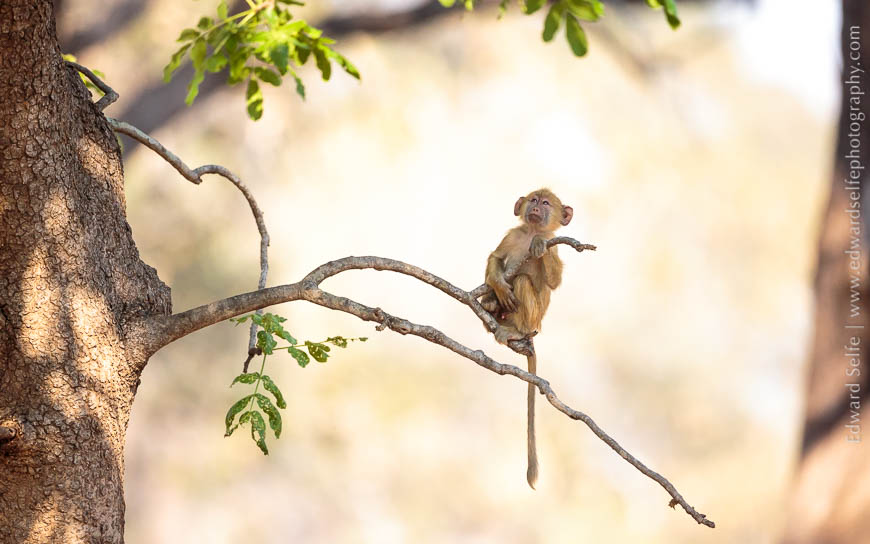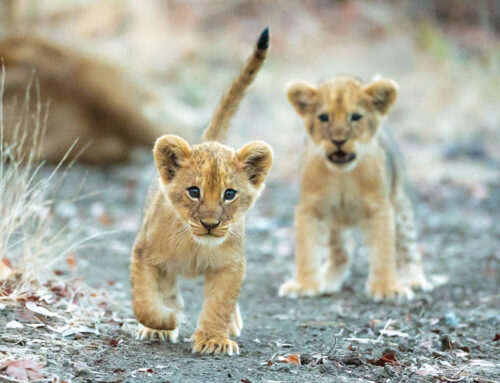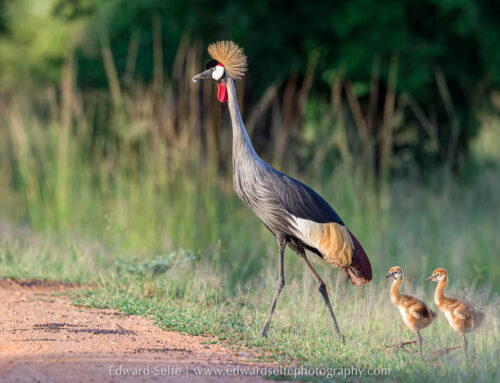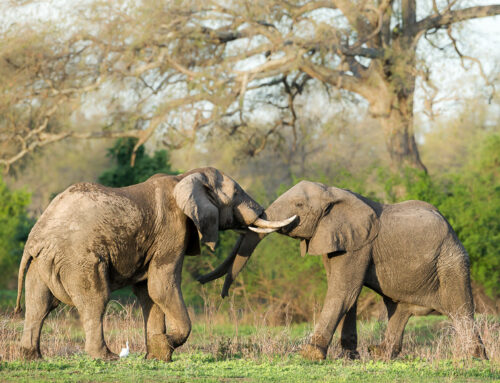Yellow baboons are found in large numbers right across the Luangwa Valley. They thrive anywhere that provides year-round forage, access to water and – crucially – safe roosting sites. They are therefore found in the largest numbers along the riverine areas where mature trees offer safe sleeping sites.
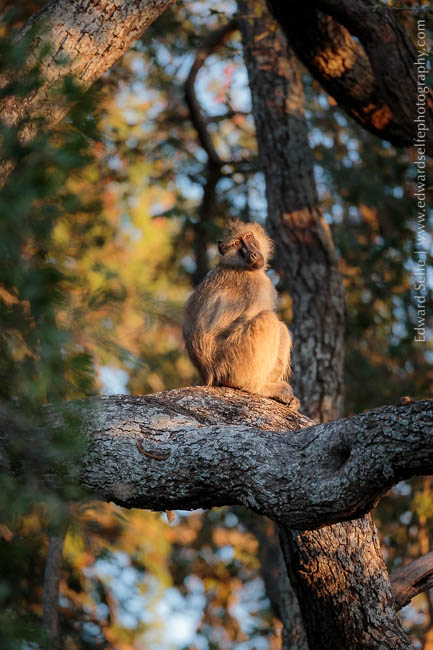
A large male baboon warms himself in a large tree after a cold night.
They are gregarious creatures, living in large troops that number up to several hundred in some places. The troop structure is crucial to their survival and success; in an area dominated by large predators such as big cats and eagles, multiple sets of eyes are the most effective way of spotting hunters before they get within striking range.
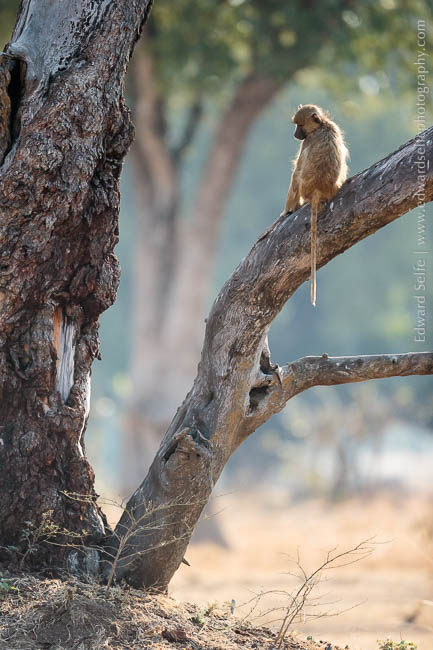
A young baboon acts as sentry for his troop from a low branch of a tree.
Within the troop, there are multiple complex layers of social interaction. Male baboons compete among themselves for dominance through strength and aggression when required; females, and juvenile males, inherit their status from their mothers, with senior females conferring senior rank on their offspring. As juvenile males mature, their status becomes less defined and they have to make the changeover into the male world of physical prowess. In the process, they may leave their natal troop to seek opportunities elsewhere.
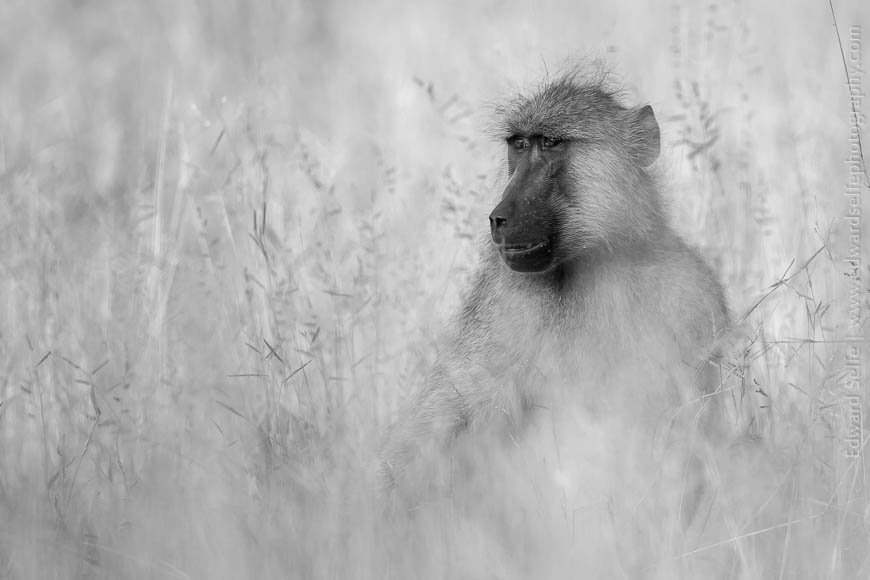
A large male baboon like this one is a dominant force in the troop. He’ll have likely immigrated from another troop at adolescence.
But, there is also the interaction between males and females of course. For a long time, it was assumed that the males which were strongest and most dominant were the ones that successfully bred. By Shirley Strum showed that social reciprocity (favours, protection, kindness and perseverance) were more likely to result in “relationships” between males and females that would lead to mating. It was certainly not true that the large, aggressive males were mating most often.
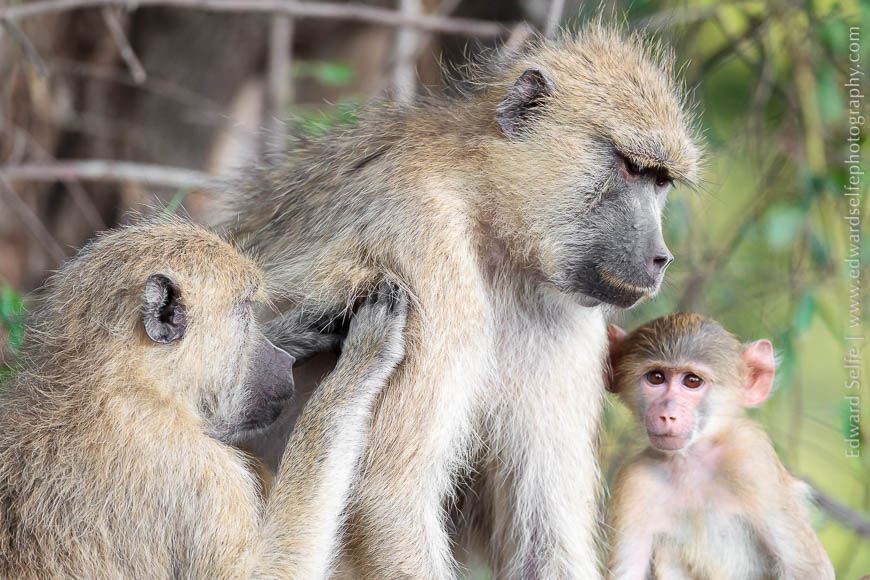
Here, a female grooms a large male – likely her friend and possibly her mate – while a youngster watches on. Interactions such as this, where females show respect for, and trust in, males are a better indication of reproductive success than displays of power and aggression.
As is often the case, once something has been identified, it’s easy to see it in action, but Dr Strum’s work went completely against the accepted understanding of primate society at that time. She proved that baboons’ society was much like our own – being based on more than just strength – a concept that she beautifully illustrates in her book Almost Human.
A baboon troop’s day begins at daybreak, when the first large males start to descend from their roosting site. For roosting, baboons prefer large trees which start to branch high up, giving them a clear view to the ground below. In Luangwa, they most commonly use groves of African Ebony trees, which are well suited and prevent leopards from climbing up among the sleeping baboons.
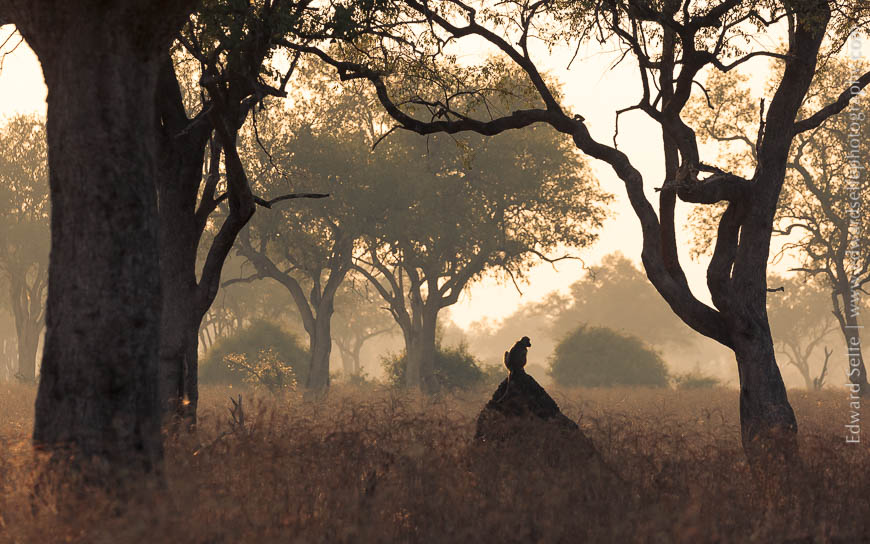
In the early morning, baboons are very tentative in their descent, wanting to ensure that there are no predators around. They’ll often sit on termite mounds or low trees and watch for danger before setting off into the surrounding areas.
Early morning is often spent greeting, grooming, playing and starting to forage for food. In the early hours, baboons move slowly, cautiously scouting for predators which might have moved in during the night. Unlike their Vervet monkey cousins which are much smaller, they are comfortable on the ground, and they spend large parts of the day digging for roots, grubs and insects in the soil. They also eat grass seeds, which they cautiously strip from the stem with their teeth, and rummage in piles of elephant droppings for insects and undigested matter.
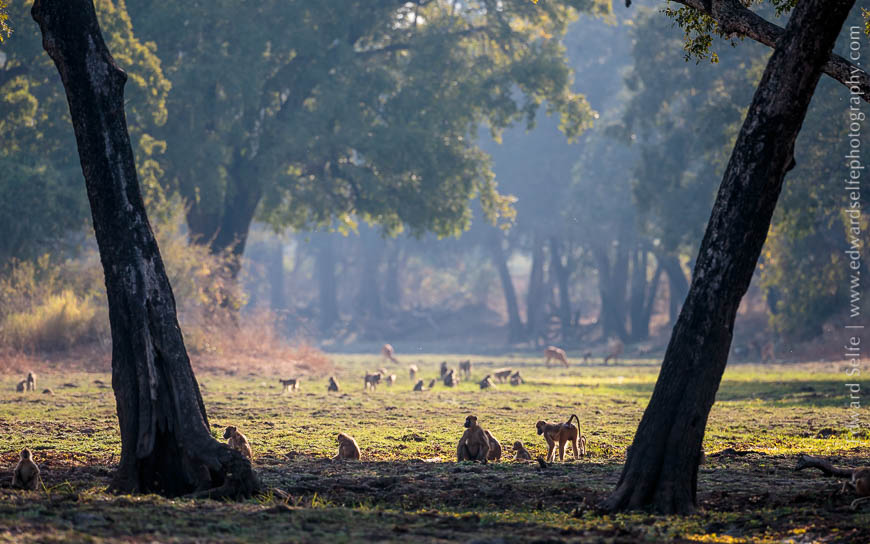
Surrouded by tall trees, baboons are vulnerable to attack from eagles, but rely on their sentry system to keep the troop safe.
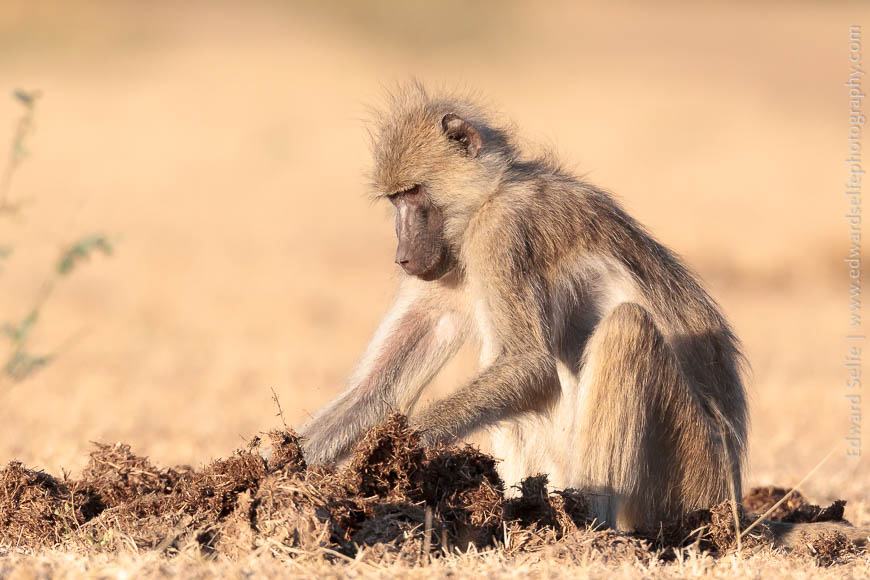
Cleaning up undigested matter in the droppings of elephants.
Being omnivores, they eat a range of foods which varies with the seasons; in summer, seed- and insect-eating is most common, with windfalls like abundant termite alates dominating their diets. Once winter comes and the grass dies back, baboons switch to fruits which become more common; baboons are well-known for biting through the tough skin of sausage fruits and gorging themselves on tamarinds.
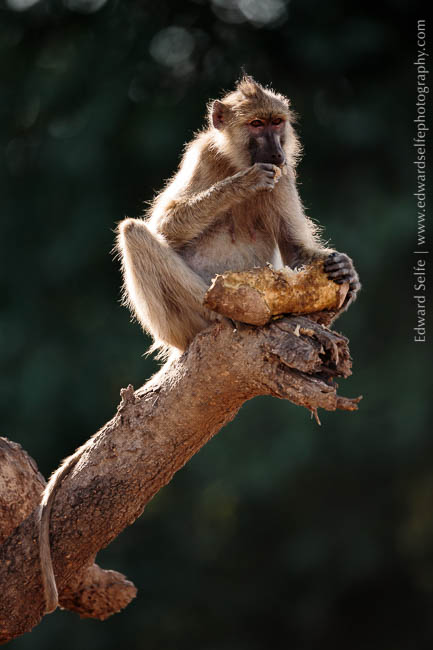
Despite their tough skin and flesh, baboons love feeding on sausage fruits especially when they are ripe and sweet.
Baboons are a favoured prey species of leopard, eagles and large snakes; but they are also highly intelligent and co-operative, meaning that they are often a match for these apex predators. By placing sentries in trees, or on top of termite mounds, most baboons can rest, feed and socialise in peace, without needing to be highly vigilant. Sharing the duties in this way allows the troop to thrive in a way that lone individuals would not.
During the day, therefore, it takes a wily and skilled hunter to get among a troop and kill an individual. It is highly likely that a sentry will have already seen the predator and sounded the alarm. Baboons have different alarm calls for different threats, notifying the troop of the type of danger approaching. Eagles can occasionally snatch youngsters from the ground and carry them away, but they must consider the risk of failing to lift off, and being “caught” by the irate gripping thumbs of family members and friends.
Even leopards, which are surely the definition of stealth and devastating power, must take be alert when stalking baboons. Killing one is perhaps not the challenge, but making off with the heavy carcass without being grabbed, bitten or attacked by the troop’s large males is not guaranteed. And baboons will certainly surround and kill leopard cubs, using their deadly canines, if their mother doesn’t keep them close. The story is certainly different at night, when leopards have the upper hand, and baboons retreat to the ends of branches to escape the cats’ approaches.
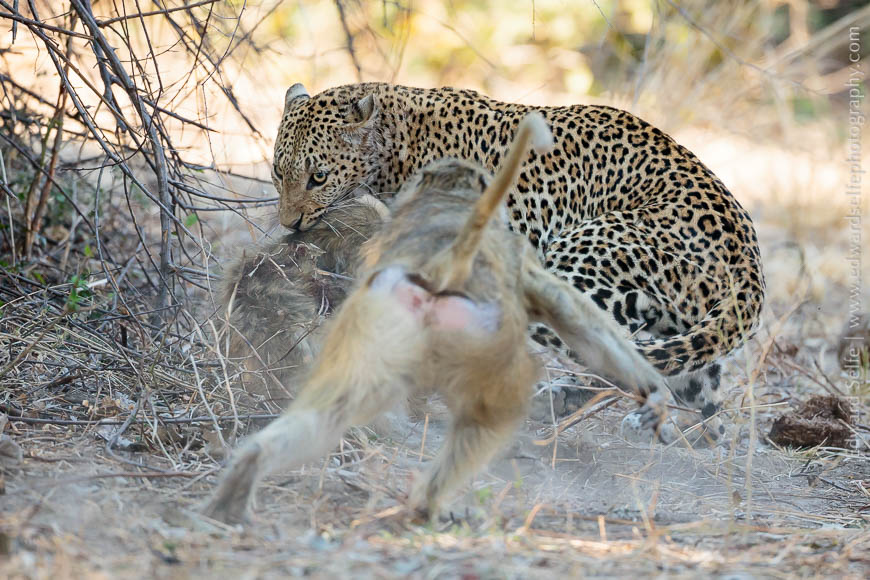
After killing a baboon, this leopard spent nearly two hours trying to recover the carcass from the rest of the troop which attacked the cat every time she appeared from the undergrowth.
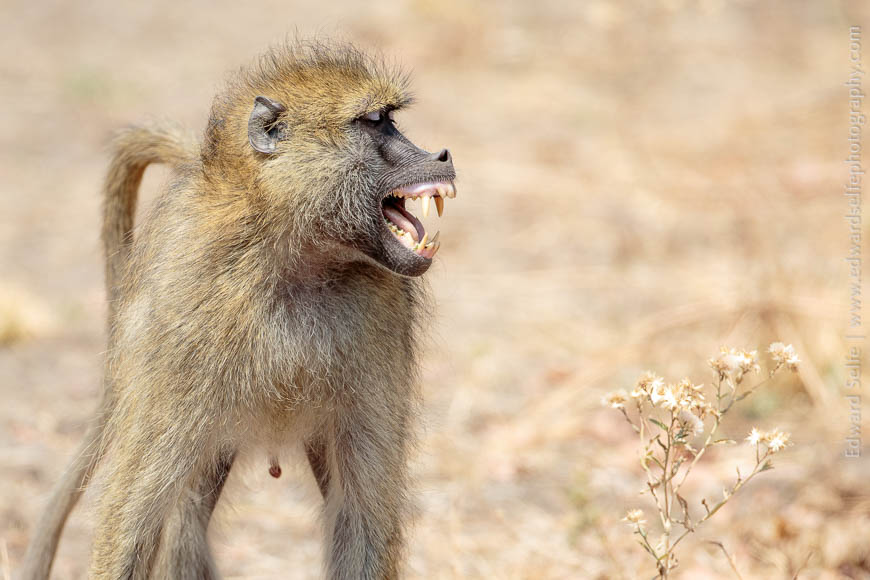
Adult baboon’s canines are a match for a lion’s.
In the Luangwa, baboons will breed at any time, but we certainly see a seasonal peak of births in the dry season when there is a glut of fruit and pods to eat. Baboons’ weaning time then coincides with the annual mango season, a real time of plenty at the start of the rains. Baby baboons’ fur is very dark in colour, gradually changing to the adult colouration at around 2 months of age. Some white baboon babies have been spotted in the Luangwa, but they are almost certainly Kinda baboon relatives, rather than albinos or pale individuals.
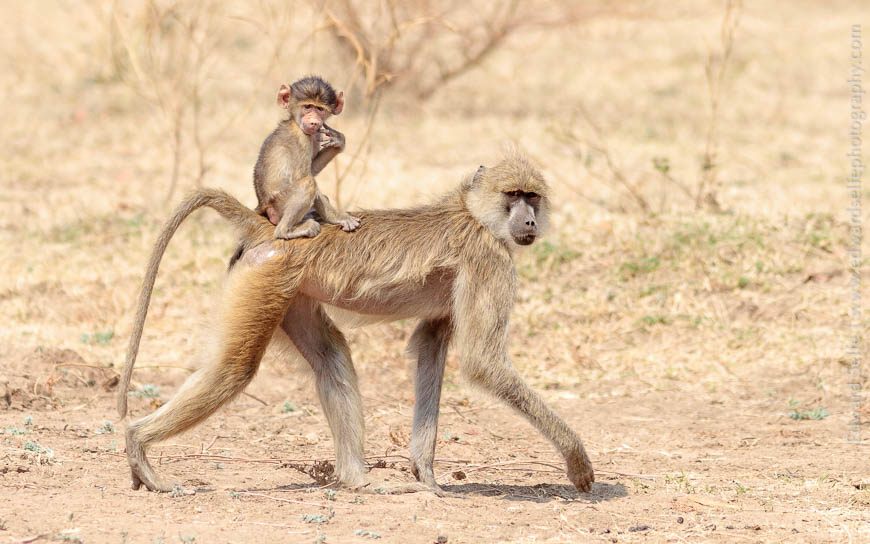
Young baboons are often carried, initially underneath and then on the back as they get older.
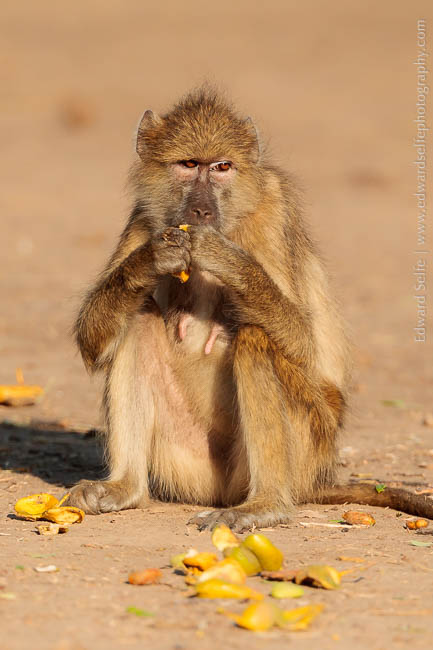
Baboons feast on mangos in November when the trees are laden with fruit.
These primates are certainly not everyone’s favourites. However, that might be because they are very similar to us and their behaviours resonate rather too closely, albeit perhaps without the discretion and moderation that human civilization has developed. But, it’s certainly true that they are smart, interesting and complex, and the safari scene would be poorer without their incredible alarm calls which have for generations helped safari guides find predators!
